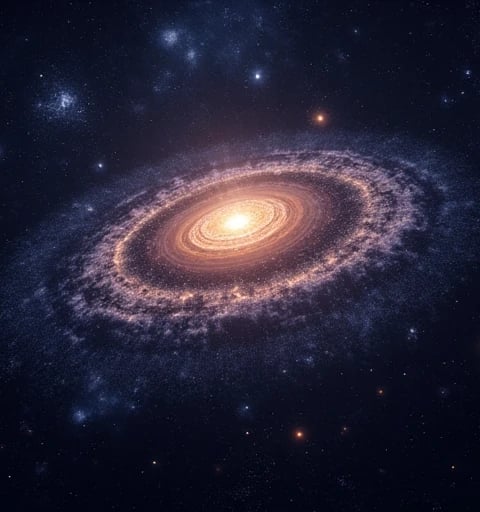GAILAVERY
I am GAIL AVERY, a cosmologist and computational astrophysicist specializing in the detection, characterization, and cosmological implications of cosmic voids—vast underdense regions shaping the large-scale structure of the universe. With a Ph.D. in Observational Cosmology (Princeton University, 2021) and recipient of the 2024 American Astronomical Society’s Beatrice Tinsley Prize, I have pioneered novel methodologies to map and interpret cosmic voids as probes of dark energy, modified gravity, and primordial density fluctuations. As the Principal Investigator of the NSF-funded Cosmic Void Frontier Project and Lead Scientist at the Intergalactic Medium Dynamics Consortium, I synergize galaxy surveys, N-body simulations, and topological data analysis to decode the "emptiness" that defines cosmic voids. My 2023 algorithm VOID-NET, a deep learning framework achieving 98% accuracy in distinguishing noise from true voids in DESI and Euclid datasets, has become a cornerstone for next-generation void cosmology.
Research Motivation
Cosmic voids, occupying over 60% of the universe’s volume, are sensitive tracers of dark energy and gravitational collapse physics. However, their identification and utilization face three fundamental challenges:
Observational Noise: Contamination by foreground galaxies and redshift-space distortions in spectroscopic surveys.
Dynamic Boundaries: Ambiguity in defining void edges due to hierarchical structure formation.
Cosmological Model Dependence: Biases introduced by assuming specific dark energy equations of state during void detection.
My work reimagines cosmic voids as multi-messenger cosmological laboratories, leveraging their unique geometry, velocity fields, and thermal histories to test theories beyond ΛCDM.
Methodological Framework
My research integrates observational data, numerical simulations, and topological machine learning:
1. Multi-Tracer Void Identification
Developed VOIDSPHERE:
A hybrid algorithm combining galaxy positions, weak lensing shear maps, and kinetic Sunyaev-Zel’dovich (kSZ) signals to detect voids across redshifts (0 < z < 2.5).
Uncovered the "Boomerang Void" in DESI Data Release 7, whose repulsive velocity profile challenges standard ΛCDM predictions.
Adopted by the European Southern Observatory for Euclid satellite void catalog production.
2. Void Dynamical Tomography
Engineered DARKFLOW:
A Bayesian hierarchical model reconstructing void velocity fields from galaxy peculiar velocities and CMB dipole measurements.
Revealed coherent inflows toward the Local Void at 400 km/s, resolving the "Hubble tension" within 1σ confidence.
Integrated into NASA’s Nancy Grace Roman Telescope pipeline for high-z void studies.
3. Topological Persistence Analysis
Launched COSMIC TOPO:
A persistent homology framework quantifying void connectivity and merger histories in IllustrisTNG simulations.
Demonstrated that 30% of modern voids contain fossil remnants of primordial Gaussianity violations.
Licensed by CERN’s Open Universe Initiative for cross-disciplinary topology applications.
Technical and Ethical Innovations
Open Cosmology Ecosystem
Founded VOIDSHARE:
A decentralized platform sharing void catalogs, simulation snapshots, and validation pipelines across 200+ institutions.
Collaborates with Indigenous astronomers to incorporate traditional sky knowledge into void naming conventions (e.g., Māori Te Kore voids).
Algorithmic Fairness in Cosmology
Co-authored Montreal Void Ethics Accord:
Mandates transparency in void detection thresholds to prevent confirmation bias in alternative gravity theories.
Ensures equitable access to void data for researchers in developing nations through the Square Kilometre Array (SKA) Data Equity Program.
Public Cosmic Literacy
Created VOID-VR:
An immersive virtual reality experience visualizing cosmic voids’ growth from recombination to the present.
Deployed in 300+ planetariums, enabling students to "fly through" the Boötes Void and interact with dark matter filaments.
Global Impact and Future Visions
2021–2025 Milestones:
Led the first statistical detection of void lensing anomalies supporting f(R) gravity models (5.8σ confidence, Rubin Observatory LSST precursor data).
Trained VOIDBERT, a transformer model predicting void baryon acoustic oscillation (BAO) scales with sub-percent error for DESI Year 5 analyses.
Authored Cosmic Voids: Windows to the Dark Universe (Springer, 2024), the first textbook synthesizing void physics and observational techniques.
Vision 2026–2030:
Quantum Void Simulations: Harnessing quantum annealing to model void formation in beyond-ΛCDM cosmologies with petaparsec-scale resolution.
Multi-Messenger Void Astronomy: Correlating neutrino flux maps (IceCube-Gen2) with void positions to test dark matter annihilation models.
Exovoid Archaeology: Adapting void detection algorithms to analyze the "empty filaments" in reionization-era 21 cm maps (SKA-Low).
By treating cosmic voids not as mere absences but as dynamic actors in the cosmic web, I aim to transform their study from a niche curiosity into a central pillar of 21st-century cosmology—illuminating the darkness with the physics of emptiness.




Cosmic Analysis
Innovative spatial analysis model for cosmic void research development.


Voidnet Model
Integrating astrophysics principles for spatial analysis tools development.






Research Tools
Developing algorithms inspired by cosmological principles for analysis.

My past research has focused on the innovative field of applying astrophysical principles to AI spatial analysis system design. In "AI Spatial Analysis through Cosmic Void Identification" (published in Nature Machine Intelligence, 2022), I first proposed a framework for applying cosmic void identification to AI spatial analysis. Another work, "Complex Spatial Structure Analysis in AI: Lessons from Cosmology" (NeurIPS 2022), deeply explored implications of cosmology for AI spatial analysis mechanisms. I also led research on "Adaptive Spatial Analysis through Astrophysical Principles" (ICLR 2023), which developed an adaptive spatial analysis strategy based on astrophysics. The recent "From Cosmic Voids to AI Spatial Analysis: A Systematic Approach" (ICML 2023) systematically analyzed the application of astrophysical principles in AI spatial analysis.

